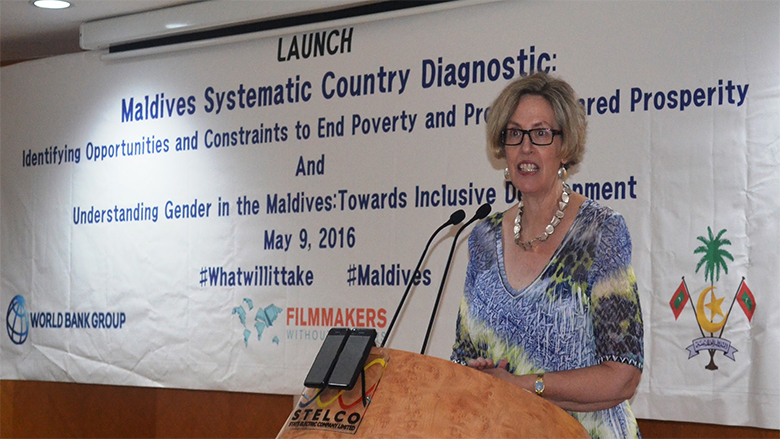The objective of the Systematic Country Diagnostic is to identify the most important constraints and opportunities facing countries as they work towards ending poverty and promoting shared prosperity.
Findings
The Maldives has developed a successful high-end tourism sector, a portion of its sizable revenues have been redistributed to the population to address development challenges. The Gross Domestic Product (GDP) per capita increased from $275 in 1980 to $6,666 in 2013. This growth rate, which averaged 7 percent between 2002 and 2013, is mainly driven by tourism and non-tradable tourism related activities (includes construction, transport and communications). However, Maldives’ development model has not been sufficiently inclusive and its immediate fiscal, environmental and social sustainability are at stake.
Sources of growth and shared prosperity
Tourism
A more inclusive tourism industry may hold the key to shared prosperity in the country. Better linkages between resorts and the local enterprises may help leverage tourism growth for development of other tradable sectors. Tourism provides a large and rapidly growing source of jobs, but most of them are not seized by the local population due to a host of factors.
Fisheries
The Maldives’ fisheries sector benefits from high value stocks, but recent declining trends highlight vulnerability to a variety of factors: including overfishing, higher fuel costs, temperature rises and lack of effective regional eco-system management of the fish stock.
Constraints to growth and shared prosperity
Maldives suffers from the same size and geography challenges as other small island states, limiting its production base and competitiveness. The investment climate in Maldives features important constraints for new entrepreneurs and for the growth of existing firms. The investment climate in Maldives is more challenging than that of similar island economies and FDI inflow has limited positive spill over to the economy. Access to finance too, has been identified as a major constraint for the development of enterprises in Maldives. Financing to the private sector has been lower than the pace of economic growth, reflecting a lack of investment opportunities in the local economy.
At the same time, Maldives lags sharply behind in education attainment at the higher secondary level, while higher education participation is low for a middle income country.
Furthermore, Maldives is facing important governance challenges including limited capacity, a complex institutional framework that also limit the ability of the state to support social and economic progress.
Vulnerabilities
Maldives’ development model is vulnerable to shocks. Some of the main vulnerabilities are
• Macroeconomic vulnerabilities: The lack of macro policy buffers leaves the country with few instruments to stabilize the economy in the event of a downturn in tourism. With high debt and an already high fiscal deficit, it will be difficult to increase expenditure or reduce taxes in the case of a downturn. Moreover, the high reliance on imported goods and fuel expose the economy and the population to risks stemming from exchange rate fluctuations
• Risks stemming from lack of inclusion, especially of the youth: The increase in the working age population, with a shift toward a relatively more educated young labor force, puts enormous pressure on the absorption capacity of Maldives labor market.
• Environmental risks due to climate change, exposure to natural disasters: Due to rising sea levels, the entire country could be submerged before the end of the century as 80 percent of land is less than 1 meter above sea level. With 42 percent of the population and more than 70 percent of critical infrastructure within 100 meters of shoreline, in the medium term, rising sea levels would have dire social and economic consequences, notably for the poorer and most vulnerable. With regards to these risks, enhancing preparedness to deal with climate change and natural disasters will be essential going forward
• Risks associated with management of water and waste: Sewage and solid waste is particularly challenging, as it has a direct impact on the country’s most valuable natural resources – coral reefs and fisheries. Uncontrolled waste disposal and floating debris at tourist resorts are the most visible threats to the country’s reputation as a pristine high-end tourist destination. They also affect the quality of ground water, with a direct impact on island communities. An estimated 248,000 tons of solid waste were generated in 2007 and this figure is expected to increase to 660,000 tons by 2020. Despite the scale of the challenge, many of the 134 Island Waste Management Centers, covering 66 percent of the islands, are not fully functional, as programs for transport of waste from these centers to a regional or central waste-processing center remain to be finalized.
In order to promote growth, poverty reduction and shared prosperity in a sustainable manner, the WBG identifies the following priority areas that need immediate attention.
1. Enhancing opportunities for the local population to benefit from existing industries.
2. Enabling opportunities for creation of new sources of growth.
3. Improving efficiency and efficacy of public resource management and public sector delivery
4. Reducing macro fiscal risks

